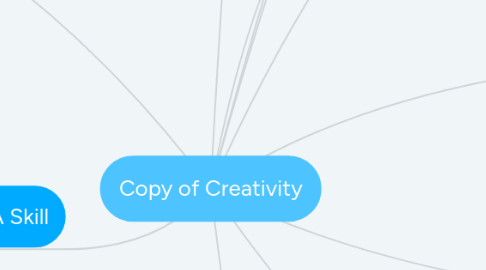
1. It is about another perspective and all about solving problems or satisfying needs. We are most likely to be creative when we are forced into it.
2. Creativity: A Skill
2.1. According to Robert Evans JR Creativity is a skill that can be found in anyone. He believes it can be found in businesses such a wallstart and that it can be mastered.
2.1.1. Observe innovators and emmulate characterstics
2.2. How To Think More Creatively
2.2.1. Three primary traits
2.2.1.1. The belief that they are creative which leads to confidence
2.2.1.2. They are flexabile in their thinking even when they don't have to be. To abandon natural traditional way of viewing things.
2.2.1.3. Exposing themselves to new experiences and different viewpoints. Opening minds to new stimuli, laying down neural pathways in their brains and, opening new channels of thought.
2.3. "Strength of your desire to solve a problem is a key factor in how quickly and how effectively you will succeed."
2.3.1. "Necessity is the mother of invention." -Plato
3. All Information comes from Tina Seeling, the executive director at Stanford technology ventures program. Tina says creativity is renewable sources we can tap into at any time and has created a book named "InGenius: A crash course of creativity".
3.1. Creativity to Tina is a process of generating ideas and not a way one way path. Requires specific tools and techniques, connecting and combining concepts and, practice to master. It is also the ability to look at problems from a different angle
4. Serotonin increases connectivity in one of its important hubs, an area called posterior cingulate cortex. Which is implicated in neuropsychiatric disorders such as bipolar depression.
5. On a biological level trauma is associated with the functional alteration of the brain. This effects the expression of genes that have an impact on brain structure which is the same large network that particpates in creativity.
6. Brains of artistically creative individuals have a particular characteristic that may enhance creativity
6.1. This characteristic is caller a smaller corpus callosum. It is the bundle of fiber which joins the hemispheres and allows the two halves of the brain to develop their own specialization.
7. Creativity is related to the connectivity of large scale brain networks. The connectivity is through to be widespread in the brain of highly creative individuals.
8. Are some people born with creativity?
8.1. DNA
8.1.1. The genes develop of pathways between two areas. That reduces the inhabitation of emotions and memory which means more information reaches the level of consciousness.
8.1.1.1. Particular cluster of genes correlated with musical creativity, involved in the plasticity of the brain.
8.2. SEROTONIN AND BIPOLAR DISORDER
8.2.1. Based on the study conducted by the Swedish scientists at the Karolinske institute in Stocklohom Individuals with bipolar disorders often ended up in professions where creativity was crucial.
8.2.1.1. Famous creative thinkers who suffered from the disorder include Winston Churchill, Beethoven and, Ernest Hemingway
8.2.2. The disorder increased self-esteem, never ending energy and motivation
8.3. GENES AND THE ENVIRONMENT
8.3.1. Many individual with artistic creativity suffer from trauma. Whether it be psychological abuse, physical abuse, neglact, hostility or regection.
9. Innovation engine which is created by Tina illustrated how creativity results from the interplay of our internal world and our external enviornment.
10. Can people learn how to be creative?
10.1. Learned Skill or Innate talent?
10.1.1. Appropriate training and focused practice.
10.2. Everyone is naturally creative, some more than others.
10.3. Knowledge provides fuel for your imagination. The process deeply influence by a myraid of factors in our environment.
10.3.1. Physical state, teams which you work with, implicit and explicit rules and rewards. It is sparked by your attitude
10.4. Can anyone learn?
10.4.1. Our brains are built for creative problem solving, which make it easy to uncover out natural incentives.
10.4.2. We are also naturally inventive and can enhance it with specific tools and techniques.
10.5. INNOVATION ENGINE
10.5.1. JUMPSTART INNOVATION
10.5.1.1. To jumpstart it is important to build your base of knowledge, build habitats that foster creativity and, cultivate an attitude that problems are opprtunities for a creative solution.
10.6. Variables that inhibit our creative thinking
10.6.1. Communities with culture have a powerful impact on how we feel, think, and, act.
10.6.2. If the culture does not support expermintation and rewards the generation of new ideas, then it is unlikely that creativity will flourish.
